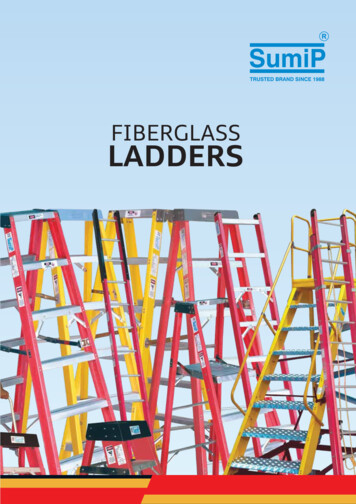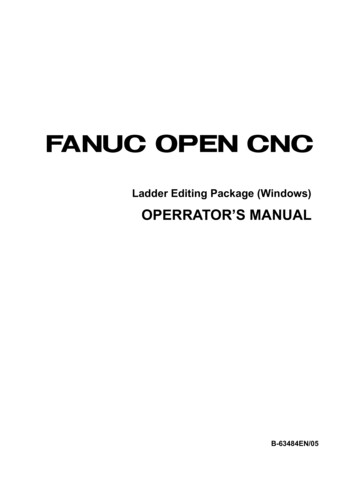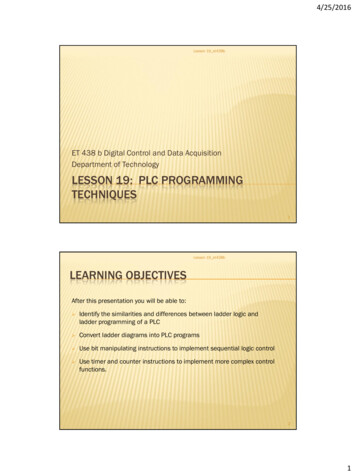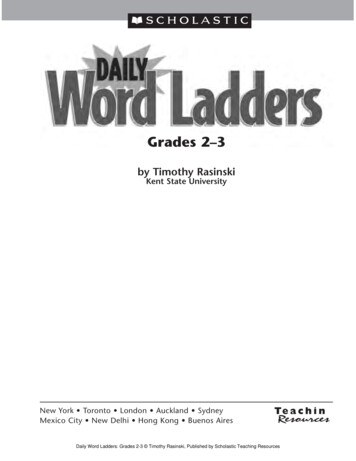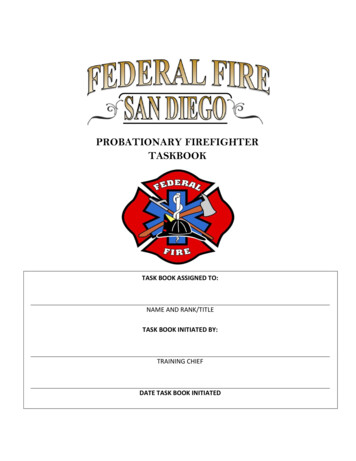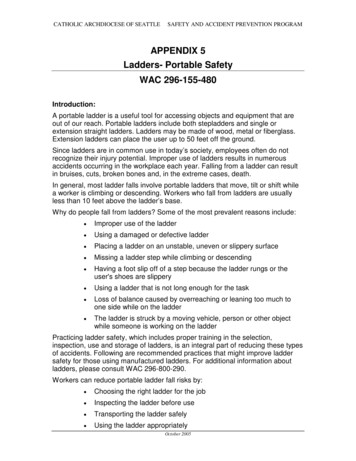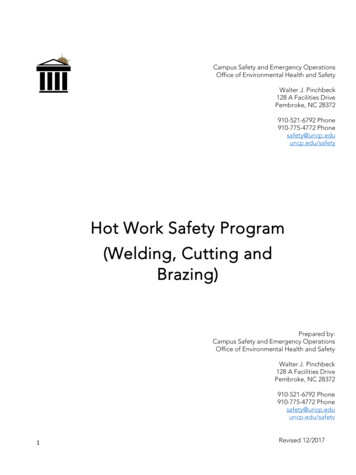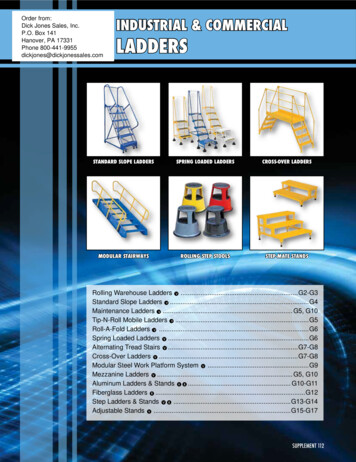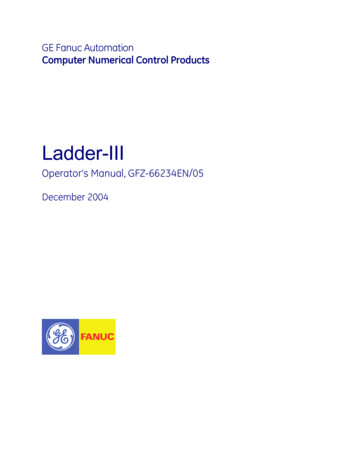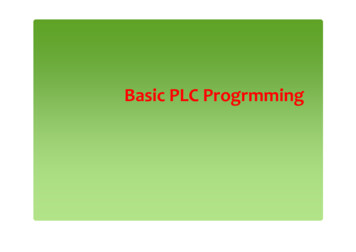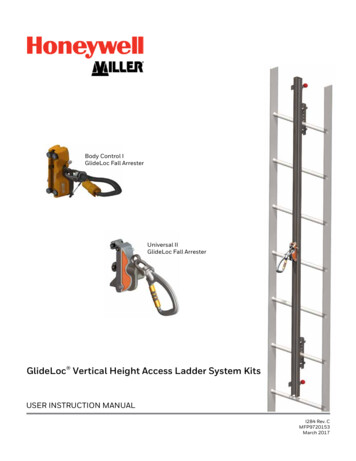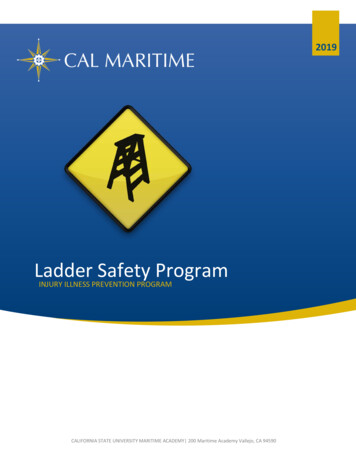
Transcription
2019Ladder Safety ProgramINJURY ILLNESS PREVENTION PROGRAMCALIFORNIA STATE UNIVERSITY MARITIME ACADEMY 200 Maritime Academy Vallejo, CA 94590
Ladder Safety ProgramThis sheet should be completed each time the Ladder Safety Program is reviewed and/or modified. The Director of Safety and Risk Managementis responsible for the review and update this document annually or more frequently as determined or needed per CSU Chancellor’s ExecutiveOrder 1039 Occupational Health and Safety Policy, 1069 Risk Management as well as Cal Maritime A&F Policy 09-004 IIPP.VersionDate ApprovedAuthorRevision Notes:1.004/01/2018Marianne Spotorno, CSPDir. Safety & Risk ManagementNew Program Document2.008/01/2019Marianne Spotorno, CSPDir. Safety & Risk Management Campus Emergency Response update. TSGB component updateElectronically Controlled. Latest revision is in the Document Management System. A printed copy is uncontrolled and may be outdated unless it bears a red ink “controlled copy” stamp.California State University Maritime AcademySafety & Risk ManagementInjury Illness Prevention ProgramDocument # 09-04029Revision: 002Page 1 of 32
Ladder Safety ProgramTable of Contents1.0 Purpose & Scope . 41.1 Regulatory Standards Reference . 41.2 CSU-System & Cal Maritime Specific Reference. 41.3 Other Resources . 42.0Administrative Duties & Responsibilities . 52.2Department of Safety and Risk Management (SRM) . 52.3Deans, Directors, Department or Operating Unit Management . 62.4Supervisors and Principal Investigators . 62.5Academic Programming Faculty and Advisors . 62.6Students- Cadets . 72.7Ladder Users . 72.1Employees (Including Student workers). 53.0 Process Management . 83.1 Hazard Identification, Risk Assessment & Control (HIRAC) . 83.1.1 Integrated Safety Management (ISM) . 83.1.2 Hazard Identification, Risk Assessment &Determining Control Table (HIRAC). 83.1.3 Application of Hierarchy of Controls . 83.1.4 Job Hazards Analysis (JHA). 93.1.4.1 JHA Requirements . 93.2 Hazard Assessment . 103.3 General Requirements . 123.3.1Ladder Safe Work Practices . 123.3.2Ladder Selection . 133.3.3Duty Ratings . 133.4Ladder Design & Use. 143.5Ladder Accessories . 163.6Fall Protection Requirements. 173.7Housekeeping . 174.0 Training Requirements . 185.0 Document Control & Recordkeeping . 19Appendix A: Definitions . 20Electronically Controlled. Latest revision is in the Document Management System. A printed copy is uncontrolled and may be outdated unless it bears a red ink “controlled copy” stamp.California State University Maritime AcademySafety & Risk ManagementInjury Illness Prevention ProgramDocument # 09-04029Revision: 002Page 2 of 32
Ladder Safety ProgramAppendix B: Job Hazard Analysis Template- Sample . 22Appendix C: Tool Inspection Sample Forms . 24Appendix D: Equipment Inventory . 27Appendix E: Job Hazard Analysis Library. 28Appendix F: Emergency Response . 29Appendix G: Accident Incident Management . 30Appendix H: Training Log . 31Electronically Controlled. Latest revision is in the Document Management System. A printed copy is uncontrolled and may be outdated unless it bears a red ink “controlled copy” stamp.California State University Maritime AcademySafety & Risk ManagementInjury Illness Prevention ProgramDocument # 09-04029Revision: 002Page 3 of 32
Ladder Safety Program1.0 Purpose & ScopeThe purpose of the Injury Illness Prevention Program (IIPP) is to outline Cal Maritime’s environmental health and safetyrequirements, expectations, and responsibilities in order to achieve effective campus safety performance through IntegratedSafety Management (ISM). The Ladder Safety Program is a subject specific component the supports the overall UniversityIIPP.The use of ladders presents significant workplace hazards. The California Bureau of Labor Statistics states that in2005, 12 people in California died from falls from ladders. Unsafe ladder use, such as using the wrong kind of ladder orupsetting the ladder’s balance by leaning too far from its center of gravity, has resulted in injuries to University employees,as well as Cal/OSHA citations and fines being assessed to CSU and UC campuses.The Department of Safety & Risk Management has developed this program to support the California State UniversityMaritime Academy (Cal Maritime) as a means to describe all aspects of ladder safety including a ladder safe-use policy,personnel accountability, hazard assessment and proper ladder selection, safe work practices, training requirements andrecord keeping.This program applies to any use of ladders three (3) feet in height/length or greater by employees of the University as partof their normal work activities. This includes temporary employees and graduate students performing research relatedactivities in field stations and remote research facilitiesThis Manual applies to all Cal Maritime operations, maintenance and construction activities under the supervision of CalMaritime personnel. For activities associated with the Training Ship Golden Bear (TSGB) refer to the Vessel Operating Manual(VOM) and/or Shoreside Administrative Manual (SAM). The TSGB is a subject specific component that supports the overallUniversity IIPP.1.1 Regulatory Standards ReferenceCalOSHA : http://www.dir.ca.gov/title8/1629.html — Stairways and Laddershttp://www.dir.ca.gov/title8/1675.html — Ladders, Generalhttp://www.dir.ca.gov/title8/1678.html — Extension Laddershttp://www.dir.ca.gov/title8/3276.html — Use of Laddershttp://www.dir.ca.gov/title8/3277.html — Fixed laddershttp://www.dir.ca.gov/title8/3278.html — Portable Wood Laddershttp://www.dir.ca.gov/title8/3279.html — Portable Metal Laddershttp://www.dir.ca.gov/title8/3280.html — Portable Reinforced Plastic Laddershttp://www.dir.ca.gov/title8/3287.html —Window Cleaning1.2 CSU-System & Cal Maritime Specific Reference EO # 1039 Occupational Safety & Health/ Injury Illness Prevention ProgramA&F # 09-004 Injury Illness Prevention Program1.3 Other Resources American Ladder Institute – www.laddersafety.orgElectronically Controlled. Latest revision is in the Document Management System. A printed copy is uncontrolled and may be outdated unless it bears a red ink “controlled copy” stamp.California State University Maritime AcademySafety & Risk ManagementInjury Illness Prevention ProgramDocument # 09-04029Revision: 002Page 4 of 32
Ladder Safety Program2.0Administrative Duties & ResponsibilitiesIt is the policy of the Cal Maritime to maintain a safe and healthy work environment for each employee (including studentand contract employees), and to comply with all applicable occupational health and safety regulations. This Injury and IllnessPrevention Program (IIPP) is intended to establish a framework for identifying and correcting workplace hazards within thedepartment, while addressing legal requirements for a formal, written IIPP.To assist Cal Maritime in providing a safe, compliant, environmentally sound, and more sustainable operation, eachdepartment or operational unit is expected to review, understand, and follow the guidance provided in the Injury IllnessPrevention Program components and the and the function of the integrated campus safety management system (ICSMS) asrelated to operations under their control.In a proactive behavior based environmental health and safety model that entire campus community participation reflects aprocess that embraces the ability to; Eliminate adverse conditions which may result in injury or illness, Recommend the establishment of programs to raise safety consciousness in the community, and Achieve and maintain a beneficial relationship through continuing communication on issues relating to environmentalhealth and occupational safety.2.1 Employees (Including Student workers)It is the responsibility of all faculty and staff to proactively participate and subsequently comply with all applicable healthand safety regulations, Cal Maritime policies, and established safe work practices. This includes, but is not limited to: Observing health and safety-related signs, posters, warning signals and directions. Learning about the potential hazards of assigned tasks and work areas. Taking part in appropriate health and safety training. Following all safe operating procedures and precautions. Participating in workplace safety inspections Using proper personal protective equipment. Inform coworkers and supervisors of defective equipment and other workplace hazards without fear of reprisal. Reviewing the building emergency plan and assembly area. Reporting unsafe conditions immediately to a supervisor, and stopping work if an imminent hazard is presented.2.2 Department of Safety and Risk Management (SRM)The Director of Safety and Risk Management (SRM), as delegated by the University President, is responsible for theimplementation and administrative management for Cal Maritime’s Injury Illness Prevention Program (IIPP) that meets therequirements of California Code of Regulations (CCR), Title 8, section 3203) as well as other applicable California and FederalOccupational Safety and Health (Cal-OSHA) requirements.Further responsibilities are outlined below: Provide advice and guidance to all university personnel concerning IIPP compliance requirements; Provide centralized monitoring of campus activities related to implementation of campus IIPP; Ensure scheduled periodic safety inspections are performed in compliance with regulatory requirements and assistmanagement staff in identifying unsafe or unhealthful conditions; Ensure safety and health training programs comply with regulatory requirements and university policy; Oversee the maintenance of safety and health records consistent with the requirements of this document andregulatory mandates; Ensure program audits, both scheduled and as required by a process, equipment or personnel change, or by a safetyprogram mandate, are performed;Electronically Controlled. Latest revision is in the Document Management System. A printed copy is uncontrolled and may be outdated unless it bears a red ink “controlled copy” stamp.California State University Maritime AcademySafety & Risk ManagementInjury Illness Prevention ProgramDocument # 09-04029Revision: 002Page 5 of 32
Ladder Safety Program Interpret existing or pending safety and health legislation and recommend appropriate compliance strategies touniversity personnel;Maintain centralized environmental and employee monitoring records, allowing employee access as directed by law.Conduct at least an annual review of this document and make the current revision available on the SRM web site.2.3 Deans, Directors, Department or Operating Unit ManagementCampus Department or Operating Unit Head leadership have an integral campus role and shall have a thoroughunderstanding of Injury Illness Prevention Program components and the function of the integrated campus safetymanagement system (ICSMS) as related to operations under their control. The Department Head has primary authority and responsibility to ensure the health and safety of the department'sfaculty, staff and students through the implementation of the Injury Illness Prevention Program components. This isaccomplished by communicating the Cal Maritime’s campus emphasis on health and safety, analyzing workprocedures for hazard identification and correction, ensuring regular workplace inspections, providing health andsafety training, and encouraging prompt employee reporting of health and safety concerns without fear of reprisal. Specific areas include employee and student (both student employees and students in academic programs) educationand training, identification and correction of unsafe conditions, and record keeping. It is recognized that a substantialamount of responsibility falls at this level. Colleges and Departments are encouraged to designate an individual as the College or department safety coordinator,to assist with specific operational environmental health and safety process management components.2.4 Supervisors and Principal InvestigatorsSupervisors play a key role in the implementation of the Cal Maritime’s Injury Illness Prevention Program components.Supervisors may be Management, Senior Research Associates, Department Chairs, Principal Investigators, or others whooversee a project and/or staff. They are responsible for but not limited to: Communicating to their staff and students about Cal Maritime campus's emphasis on health and safety. Ensuring periodic, documented inspection of workspaces under their authority. Promptly correcting identified hazards. Modeling and enforcing safe and healthful work practices. Providing appropriate safety training and personal protective equipment. Implementing measures to eliminate or control workplace hazards. Stopping any employee’s work that poses an imminent hazard to either the employee or any other individual. Encouraging employees to report health and safety issues without fear of reprisal.2.5 Academic Programming Faculty and AdvisorsIt is the responsibility of Faculty, Academic Programming Advisors other Cal Maritime related activities and student clubs to: Develop procedures to ensure effective compliance and support of the Injury and Illness Prevention Programcomponents as it relates to operations under their control. Specific areas of responsibility include student educationand training, identification and correction of unsafe conditions, and incident reporting. Develop and maintain written classroom, laboratory, and activity procedures which conform to regulatory, campusand departmental guidelines. Instruct students in the recognition, avoidance, and response to unsafe conditions, including hazards associated withnon-routine tasks and emergency operations Permit only those persons qualified by education and training to operate potentially hazardous equipment or usehazardous materials, unless under close supervision. Supervise students in the performance of activities.Electronically Controlled. Latest revision is in the Document Management System. A printed copy is uncontrolled and may be outdated unless it bears a red ink “controlled copy” stamp.California State University Maritime AcademySafety & Risk ManagementInjury Illness Prevention ProgramDocument # 09-04029Revision: 002Page 6 of 32
Ladder Safety Program2.6 Students- CadetsStudents are expected to always adhere to safety practices presented by faculty, technical staff, student assistants, graduateassistants or other authorized individuals. They must also report potentially hazardous conditions that become known tothem. These reports should be made to their supervisors, faculty advisers, Department of Safety and Risk Management, orother responsible parties.2.7 Ladder Users Is trained on and applies “Safe-Work Rules” for users as outlined in this program.Always selects and uses a hand and power tools in a safe manner.Visual inspect prior to use.Alerts Owner Department Management when hand and/or power tools need repair/replacement.Assesses work to determine if fall protection should be worn and seeks alternative access methods instead of handand/or power tools if need be.Proactively use Stop Work Authority when they feel there is an unsafe condition present by means ofcommunicating with Department Management and SRM to work collaboratively to resolve and improve identifiedor perceived condition.Electronically Controlled. Latest revision is in the Document Management System. A printed copy is uncontrolled and may be outdated unless it bears a red ink “controlled copy” stamp.California State University Maritime AcademySafety & Risk ManagementInjury Illness Prevention ProgramDocument # 09-04029Revision: 002Page 7 of 32
Ladder Safety Program3.0 Process Management3.1 Hazard Identification, Risk Assessment & Control (HIRAC)3.1.1 Integrated Safety Management (ISM)Cal Maritime is committed to having all campus-related work performed safely and in a manner that strives for the highestdegree of protection for the Campus Community. To achieve these goals, Cal Maritime implements, the principles of safetythrough an Integrated Campus Safety Management System (ICSMS).Simply put, ICSMS applies a plan-do-check-act approach to campus safetymanagement. Five core activities represent the plan-do-check-act approach,and comprise the underlying process for any construction work activity. The fivecore activities are:1) Define the Scope of Work2) Analyze the Hazards3) Develop and Implement Hazard Controls4) Perform Work Within Controls5) Provide Feedback and Manage ChangeThe identification and analysis of workplace hazards is part of the pre-work planning process. The goal of this core activity isto ensure that the hazards associated with construction work activities are clearly understood and appropriately managed.All new campus work activities, changes to existing work or introduction of new equipment or processes (which introducenew hazards or increase the hazard level) need to be reviewed to analyze hazards, identify safety standards/requirements,and establish appropriate controls. Safety conditions and requirements need to be formally established and in place beforeconstruction work is initiated.The campus Job Hazards Analysis (JHA) process is the principle method for achieving this.3.1.2 Hazard Identification, Risk Assessment &Determining Control Table (HIRAC)The EHS Hazard Identification, Risk Assessment and Determining Control Table (HIRAC) process is used to identify, assess andrisk-rank Cal Maritime campus-related activities in order to ensure that Cal Maritime Campus Safety programs, activities andwork controls are appropriately addressing construction risks. The initial HIRAC assessment and risk-ranking of campusrelated activities was conducted during the third quarter, AY 2016-2017. The HIRAC assessment will be reviewed annually,when new campus-related activities are introduced that create or modify assessed risks, and when worksite observations oraccident/incident experience identify previously unrecognized or incorrectly categorized risks.3.1.3 Application of Hierarchy of ControlsIn developing hazard controls and preparing the Job Hazard Analysis submittal, the campus shall select means and methodsto mitigate worker exposure to workplace hazards using the Hierarchy of Controls as specified in the American NationalStandards Institute (ANSI) Z10-2005 Occupational Health and Safety Management Systems.The campus shall make a good faith effort to analyze each hazard and identify the appropriate control(s) using the followinghierarchy: Elimination or substitution of the hazards where feasible and appropriate; Use of engineering controls where feasible and appropriate; Application of work practices and administrative controls that limit worker exposures; and Provision and use of personal protective equipmentElectronically Controlled. Latest revision is in the Document Management System. A printed copy is uncontrolled and may be outdated unless it bears a red ink “controlled copy” stamp.California State University Maritime AcademySafety & Risk ManagementInjury Illness Prevention ProgramDocument # 09-04029Revision: 002Page 8 of 32
Ladder Safety Program3.1.4 Job Hazards Analysis (JHA)For the purposes of this section Job Hazard Analysis (JHA) and Job Safety Analysis (JSA) can be used synonymously. A JHA/JSAcan be incorporated into a Pre Task Plan, provided there is a section for employees to review, comment and sign. Corecomponents of the scope of work and relative hazards can be electronically completed ahead of time, provided there is roomfor current site conditions are able to be readily added as applicable. When the scope or conditions change, the change inwork plan should be noted in a different colored pen with employee’s initially that they have been briefed on the change.The Department of Safety and Risk Management will work with individual Departments to develop a master Campus JHAlibrary. Each employee scheduled to work in the activities identified below shall receive safety training in those activitiesprior to working on them. Subcontractors shall submit a Job Hazards Analysis (JHA) for those construction activities meeting the requirementsfor performing JHA (see below). The JHA shall be reviewed and authorized to proceed by the Cal MaritimeDepartment of Safety and Risk Management before work commences. Subcontractor shall be responsible for submitting a JHA and work procedures to Cal Maritime Department of Safetyand Risk Management for review a minimum of seven days prior to the start of work for most work activities.3.1.4.1 JHA RequirementsA JHA shall be written based on the following conditions: Jobs with the highest injury or illness rates Jobs with the potential to cause severe or disabling injuries or illness, even if there is no history of previous accidents Jobs in which one simple human error could lead to a severe accident or injury Jobs that are new to your operation or have undergone changes in processes and procedures Jobs complex enough to require written instructions.If not otherwise specified in a particular project specification, the JHA shall be performed in accordance with the OSHA 3071.JHA processes. In general the JHA will include: Description of work phase or activity Identification of potential hazards associated with the activity Address further hazards revealed by supplemental site information (e.g., site characterization data, as-built drawings)provided by the subcontractors construction manager. A list of the Subcontractor’s planned controls to mitigate the identified hazards Identification of specialized training required Identification of special permits required Name of the Subcontractor’s Competent Person(s) responsible for inspecting the activity and ensuring that allproposed safety measures are followed.Electronically Controlled. Latest revision is in the Document Management System. A printed copy is uncontrolled and may be outdated unless it bears a red ink “controlled copy” stamp.California State University Maritime AcademySafety & Risk ManagementInjury Illness Prevention ProgramDocument # 09-04029Revision: 002Page 9 of 32
Ladder Safety Program3.2 Hazard AssessmentNote: Each Work Activity will have its own JHA and/or Pre-Task Plan, refer to the JHA Library for more details.GENERAL HAZARD IDENTIFICATION & CONTROL MEASURES FOR EQUIPMENT USETASKHAZARDCLIMBING/ LADDER USEFalling,ElectricalConductivityHAZARD CONTROLS & PROTECTION MEASURESThe construction, installation, and use of ladders shall conform to ANSI A14.1, ANSI A14.2, ANSIA14.3, and ANSI A14.4, as applicable.Length of ladders.1. All portable ladders shall be of sufficient length and shall be placed so that workers will notstretch or assume a hazardous position.2. Portable ladders, used as temporary access, shall extend at least 3 ft (0.9 m) above theupper landing surface. The length of portable stepladders shall not exceed 20 ft (6 m).Width of ladders.1. The minimum clear distance between the sides of individual rung/step ladders shall be 16in (40.6 cm).2. The minimum clear distance between side rails for all portable ladders shall be 12 in (30.4cm).Spacing of rungs, cleats, and steps on ladders.1. On portable ladders, spacing of rungs shall be 8 in (20.3 cm)- 14 in (35.5 cm) on center anduniform.2. On step stools, spacing shall be not less than 8 in (20.3 cm) or more than 12 in (30.4 cm)apart, as measured from their centerlines.3. On extension trestle ladders, spacing on the base section shall be not less than 8 in (20.3cm) or more than 18 in (45.7cm) apart, as measured from their centerlines. On theextension section, spacing shall not be less than 6 in (15.2 cm) or more than 12 in (30.4 cm)apart, as measured from their centerlines.4. Ladders shall be surfaced so as to prevent injury to a worker from punctures or lacerationsand to prevent snagging of clothing.5. Wooden ladders shall not be coated with any opaque covering, except for identification orwarning labels that may be placed on only one face of a side rail.A metal spreader bar or locking device shall be provided on each stepladder to hold thefront and back sections in an open positionSet-up of ladders.1. Ladders shall not be placed in passageways, doorways, drives, or any locations where theymay be displaced by any other work unless protected by barricades or guards.2. Portable ladders shall be used at such a pitch that the horizontal distance from the topsupport to the foot of the ladder will not be greater than ¼ the vertical distance betweenthese points.3. Wooden job-made ladders, with spliced rails, shall be used at an angle such that thehorizontal distance is 1/8 the length of the ladder.4. Ladders shall be secured by top, bottom, and intermediate fastenings, as necessary to holdthem rigidly in place and to support the loads that will be i
2005, 12 people in California died from falls from ladders. Unsafe ladder use, such as using the wrong kind of ladder or upsetting the ladder's balance by leaning too far from its center of gravity, has resulted in injuries to University employees, as well as Cal/OSHA citations and fines being assessed to CSU and UC campuses.
